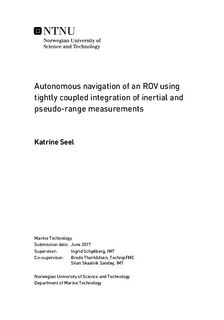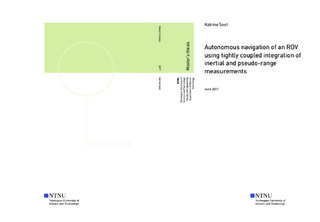| dc.description.abstract | Underwater navigation is one of the key issues that need to be addressed in order to make operation of underwater vehicles more autonomous. This thesis investigates two different methods for integration of inertial and pseudo-range measurements that is to be suited for underwater navigation of a Remotely Operated Vehicle (ROV). For underwater applications acoustic range measurements can be provided by Long Baseline (LBL) systems. And if the wave speed for which the acoustic signals propagate with is unknown, the measurements will be corrupted by an uncertainty modeled as a slowly-varying bias. The measurements are then referred to as pseudo-range measurements. An Inertial Measurement Unit (IMU) that is mounted on the underwater vehicle can measure the vehicle s linear accelerations.
A Three-Stage filter (TSF) was implemented for integration of inertial and pseudo-range measurements. The filter estimates the position, linear velocities, and a wave speed bias parameter in addition to acceleration measurement biases. Because the filter uses tightly coupled integration, the raw measurements are used directly in the filter, and the estimation problem is nonlinear. The TSF is based on a novel approach of using an exogenous state estimator for providing an external estimate. This is used to linearize a second filter. And consequently it can be proven that the error dynamics have global exponential stability (GES). An Extended Kalman filter (EKF) was implemented for the same estimation problem, also using a tightly coupled integration.
A simulator was built in MATLAB, so the TSF and EKF could be verified and compared in simulations. Range and acceleration measurements were generated at realistic frequencies, 2 Hz and 100 Hz respectively. The measurements were added a realistic amount of noise, and in addition the acceleration measurements were corrupted by a constant bias. The filters were initialized with accurate initial estimates, and showed similar performance in steady-state, resulting in a similar Root-Mean-Square (RMS) position estimation error. Initializing the filters with inaccurate initial state estimates tested the transient behavior of the filters. And the plotted states suggested that the TSF converged faster in transient behavior. Also the TSF converged with a smaller overshoot than the EKF estimates. This resulted in a smaller RMS position estimation error in transient behavior.
Physical experiments were conducted in the MC-laboratory at NTNU, where a test basin facilitates underwater experiments. An underwater positioning system, Qualisys Motion Tracking (QMT), was used to obtain the position of the ROV and was used as ground truth for the estimated position. Two different methods were used for generating range measurements, and two different ROVs were used to perform experiments. All sensor data was logged during both experiments, and used for offline tests of the integration filters. The data sets were used for testing steady-state and transient behavior of both filters. Overall the experimental results backed the same trends as seen in simulations, in favor of similar performance in steady-state and TSF having a faster transient behavior.
The EKF is currently the standard choice for integration of measurements for nonlinear estimation problems. The performance of the filters could vary beyond what has been found in this thesis, due to uncertainties related to the "true values" available during experiments, tuning of the filters or variations that come with different transponder set-ups. However, results from both simulations and two different experiments indicated good performance of the TSF when benchmarked against the EKF. To conclude, the TSF, based on the investigation done in this thesis, is recommended for the estimation problem considered. This inspires further work to continue examining the performance and the potential that the TSF could have for underwater navigation of ROVs. | |

